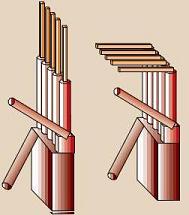By Casey LuskinTwo Different Views of Origins

Figure 1. The panda's thumb. Figure Adapted by permission from Macmillan Publishers Ltd: Nature, "Role of the giant panda’s pseudo-thumb," Nature, Vol: 347:309-310, 1999. |
|
Many famous evolutionists (like Stephen Jay Gould) have popularized an argument that the panda's thumb is "poorly designed" and thereby could not have been designed. This argument makes its way into popular books, such as Edward Humes' book
Monkey Girl which observes that Gould wrote an essay “about the panda’s unusual adaptation for stripping the bark from bamboo shoots—a rather clumsy extra thumb—as a proof of evolution in action.” (pg. 198) More specifically, Gould argues that the "thumb" of the panda (which really consists of uniquely modified wrist bones) functions much worse for grasping objects, such as bamboo shoots, than does the true opposable thumb found in humans and therefore Gould says it has poor design. ID proponents find this to be a very weak argument against design for 2 reasons.
First, poor or "sub-optimal" design does NOT refute design for poorly functioning objects can still be designed. (Ever used Microsoft Windows?)
Second, it turns out that the panda's thumb is NOT poorly designed. The human opposable thumb would actually NOT be a good design to accommodate 12 hours/day of scraping leaves from bamboo branches (which is what pandas do) however the panda's thumb can accomplish this function without a problem. A study published in
Nature used MRI and computer tomography to analyze the panda's thumb and concluded the following:
"The radial sesamoid bone and the acessory carpal bone form a double pincer-like apparatus in the medial and lateral sides of the hand, respectively, enabling the panda to manipulate objects with great dexterity."
(Hideki Endo, Daishiro Yamagiwa, Yoshihiro Hayashi, Hiroshi Koie, Yoshiki Yamaya, Junpei Kimura, "Role of the giant panda’s pseudo-thumb," Nature, Vol: 347:309-310, January 28, 1999, emphasis added).)
The authors go on to marvel at the functionality of the panda thumb saying, "[t]he way in which the giant panda .. uses the radial sesamoid bone -- its 'pseudo-thumb' -- for grasping makes it one of the most extraordinary manipulation systems in mammalian evolution." That doesn't sound like "poor design" to me and I think the "panda's thumb is poor design" argument is now a Darwinian urban legend that has been debunked.
